Asset Allocation | Trading Rules You Need To Master
Asset allocation merely implies allocating different assets comprising one's portfolio according to priorities, tolerance for risk and investment horizon of an investor. It is the most critical and fundamental aspect of investment and trading. Even today, few investors are still unaware of the importance of asset allocation in creating and maintaining wealth in achieving financial goals. Read here five important pointers from Valiant Markets that you need to know.
This isn't about 'that.'
When it comes to diversification by allocating assets, some investors might feel a bit overwhelmed and confused. It is primarily so because the two words are often used interchangeably. The allocation of assets is the method of determining the amount of exposure to various types of investments. Its diversification signifies how much exposure one has to have in one asset class to varying securities. The allocation of assets simply means the share or exposure to equity, bonds, gold, cryptocurrencies, and other alternative investment avenues. However, it does not mean that the financial targets are matched with the assets you have in the equity portfolio.
The 'tactic' of investment
Experts from ValiantMarkets share that all investment strategies have a central motive, and that is the achievement of financial objectives. Because stocks are considered to be a more active way of investing that can produce higher income, the asset allocator can be more exposed to shares, regardless of the risk involved. The asset award is selected on the basis of analysis and understanding.
Understanding the "varying" nature
For each portfolio, the distribution of assets is not the same. It depends mainly on the risk with which an investor is comfortable. An individual who aims at achieving financial targets in 2-3 years; his portfolio is going to be different from the one who has thought to invest for 10-15 years to meet his/her financial objectives. The distribution of assets often has various phases in an investor's investment horizon, depending on their needs and goals.
Acting in equilibrium
An essential element of asset allocation is that all investors need to understand the finer nuances of risk-return balance, which helps them to create a perfect and optimally diversified portfolio.
As the primary objective of asset allocation is to optimize the risk and return, it is essential that the risk-return features of the various asset classes and sub-asset classes are understood in their entirety. The portfolio of long-term investors who intend to remain invested in equities will benefit from that.
In that context, Valiant Market experts share that the investor can also stratify part of their portfolio for other assets in order to preserve a sense of stability if he/she has invested in more volatile or risk-based securities to generate greater returns. This is another driver of a diversified portfolio, which reduces losses in the portfolio. It is also commonly said, "Don't put your entire lot of egg in the same basket."


.png)
Comments
Post a Comment